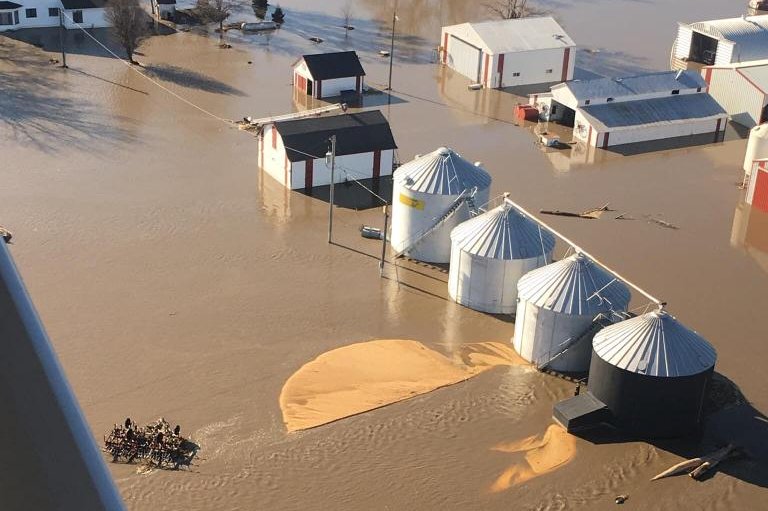A 2019 aerial view of a flooded farm in western Iowa shows two burst grain bins with golden corn spilled across the ground. File Photo courtesy of Beth Kellogg
EVANSVILLE, Ind., Feb. 6 (UPI) -- Midwestern farmers, who endured record-breaking floods in 2019 that hindered planting and harvesting, now face the strong possibility that widespread flooding will return for the 2020 planting season.
"It will probably be more of the same," said Tom Christensen, a farmer in southeastern North Dakota who grows wheat, corn and soybeans.
The problem, Christensen said, is that the ground is still soaked from last year's flooding, and it simply can't absorb any more water.
"In much of the Midwest, soils are at record saturation," said Bryce Anderson, a senior agricultural meteorologist at DTN, a Minnesota-based analytics company that tracks agricultural markets and weather. "So, that means any occurrence of precipitation, even normal amounts, is likely going to be too much."
Early predictions from the National Weather Service indicate much of the Midwest could be in for another year of above-average rainfall this spring. If conditions remain this wet, farmers will struggle again to get their crops planted.
In 2019, a record 20 million acres qualified for federal "prevent plant" insurance claims. That means flooding prevented farmers from planting 20 million acres of insurable crops.
Of the crops that were planted, it's unclear how many acres farmers were able to harvest.
In North Dakota, Christensen still has not harvested his corn. The ground in his area never dried out enough for him to drive his tractor into the fields.
Corn can keep in fields over winter, but with more rain coming, Christensen fears he won't be able to harvest those fields in time to plant a new crop.
Many of the farmers in his area are in similar situations, Christensen said.
"I imagine this will reduce incomes again," he said. "Depending on their financial situation, some farmers could be done."
North Dakota farmers are not alone. In Iowa, nearly 75 percent of Leo Ettlemen's fields were too flooded to plant in 2019.
"It is still too wet for us to get to the fields," said Ettlemen, who grows corn and soybeans. "I've got fields still covered in sand with holes and debris all over them. We're going to need a lot of dry weather this year to get our fields planted."
Springs are becoming wetter across much of the corn belt, Anderson said, adding, "It's the impact of climate change."
Warmer temperatures are bringing more frequent -- and much heavier -- rains to the region, he said.
"We are on a long-term trend of having wetter springs," Anderson said. "And I don't see anything that is getting us away from that this year."















